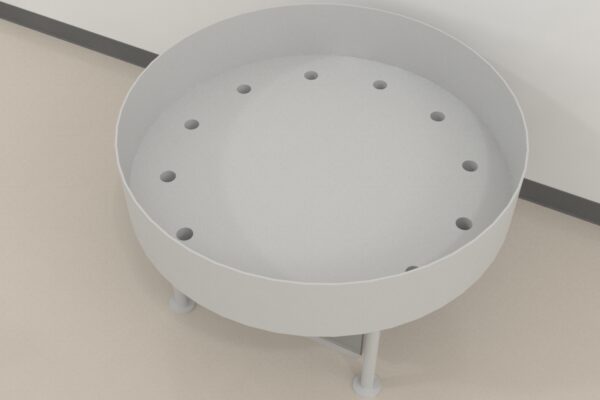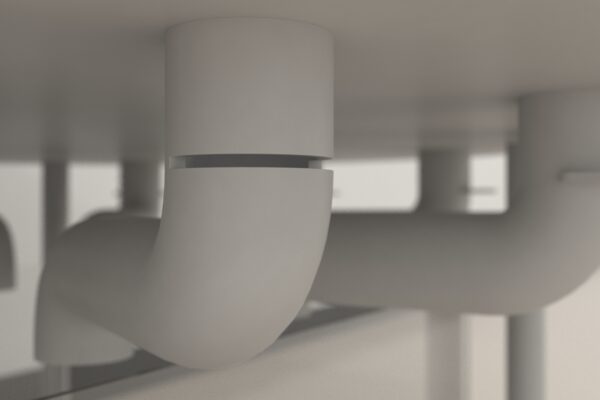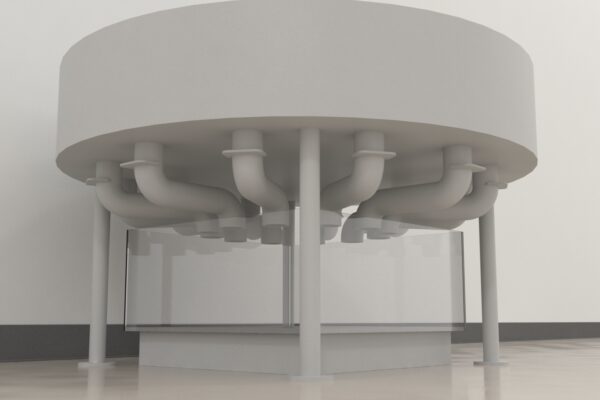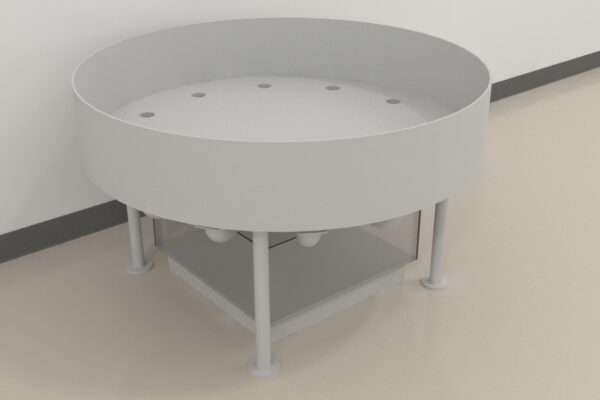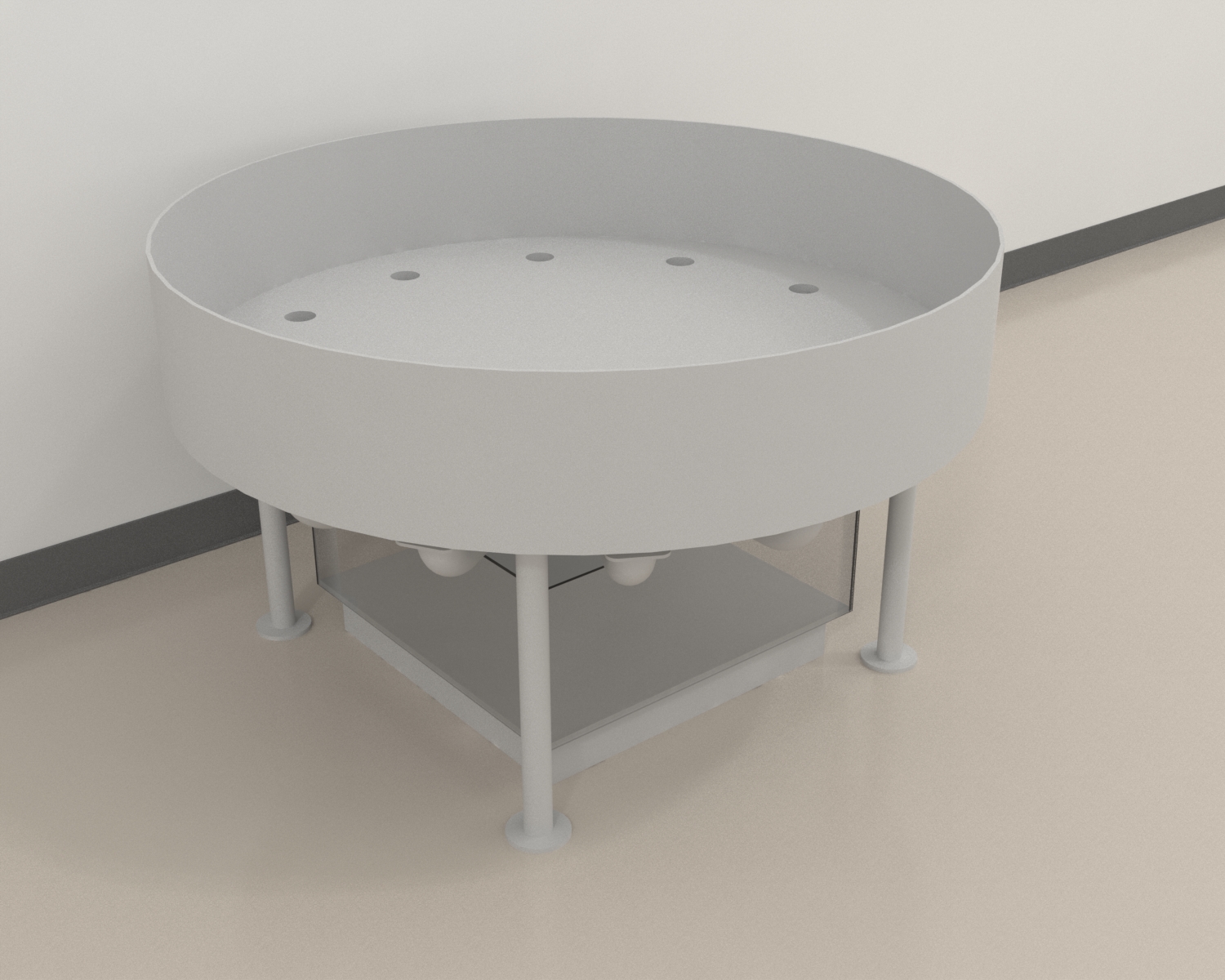
The Circular Hole Board consists of a removable white round plexiglass plate elevated 50 cm above a table. The plate includes 12 holes that measure 5 cm in diameter and are placed at equal distances from each other. Each open hole serves as the exit that leads to the animal’s home cage via an S-shaped tunnel.
The Circular Hole Board is used to study spatial learning, memory, and spatial navigational strategies in rodents. It is an adaptation of the Hole Board apparatus used to assess rodents’ exploratory behaviors. The Circular Hole Board tests the ability of rodents to remember the correct open hole across trials.
Maze Engineers offer the Circular Hole Board.
Documentation
Introduction
The Circular Hole Board is used to study spatial learning, memory, and spatial navigational strategies in rodents. It is an adaptation of the Hole Board apparatus used to assess rodents’ exploratory behaviors. It consists of a round plate with 12 holes elevated above a table. Each hole can be opened or closed, and each open hole leads to a tunnel that serves as the exit, which eventually leads to the subject’s home cage. The Circular Hole Board tests the ability of rodents to remember the correct open hole across trials.
Rodents mainly utilize allocentric or egocentric navigational strategies to explore and navigate their environments. In allocentric navigation or spatial navigation, distal cues such as landmarks located at a distance are utilized. In contrast, in egocentric navigation, the animal uses its internal self-movement cues to navigate (Vorhees & Williams, 2014). The Circular Hole Board can effectively be used to evaluate navigational strategy preferences in rodents. During the task, extra maze cues and intra-maze cues can be placed to investigate how they affect task performance. Particularly, an intra-maze cue can be placed beside the open hole across trials and then relocated to another hole to investigate whether the subject will utilize a landmark-based navigational strategy or a cognitive map-based navigational strategy. Additionally, the Circular Hole Board can be applied for different investigatory protocols, such as to test the effect of pharmacological manipulations on spatial learning performance or test how brain lesions or diseases and disorders affect spatial learning and memory.
Other apparatuses used to study spatial learning and memory in rodents include the Radial Arm Maze, the Hebb Williams Maze, and the Morris Water Maze.
Apparatus and Equipment
The Circular Hole Board consists of a removable white round plexiglass plate that measures 120 cm in diameter and is elevated 50 cm above a table. The plate includes 12 holes that measure 5 cm in diameter and are placed at equal distances from each other. The holes are 10 cm from the board’s rim and can be closed by a lid at a depth of 5 cm. Each open hole serves as the exit that leads to the animal’s home cage via an S-shaped tunnel that is 15 cm long and 5 cm in diameter.
Mouse
$ 4490
Per Month- 120cm diameter
- Elevation: 50cm
- 12 holes, 5cm diameter
Training Protocol
Clean the apparatus thoroughly after every trial. Appropriately light the apparatus. A tracking and recording system such as the Noldus Ethovision XT can be used to assist with observations.
Habituation and Pre-training
Place the subject in the middle of the Circular Hole Board and train it to return to its home cage via the tunnel before the start of spatial learning trials.
Free-exploration Trial
Conduct a free-exploration trial to assess the general locomotor activity of the subject before any pharmacological treatment.
Place the subject in the middle of the Circular Hole Board and allow it to explore it for 5 minutes.
Circular Hole Board Spatial Learning Task
Keep only one of the holes of the board open. Place extra maze cues in the testing room. Place the subject in the middle of the Circular Hole Board and allow it to explore the apparatus. Allow the subject to find the open hole within 2 minutes. Allow the subject to exit to its home cage via the open tunnel. If the subject doesn’t find the hole within 2 minutes, gently push the subject to the open hole and allow it to exit via the tunnel. Conduct six trials with intertrial intervals of 15-20 minutes. Keep the same hole open across all trials.
Circular Hole Board Conflict Task
After one week, perform Conflict Trials. Keep a different hole open from the spatial learning task to serve as the exit and let all the other holes remain closed. Place a bottle next to the open hole to serve as the cue. Conduct five trials in the same manner as the spatial learning task. Conduct one last strategy trial with the bottle moved to the opposite tunnel, keeping both tunnels open.
Literature Review
Investigation of the effect of cannabinoid type 1 (CB1) receptors on the spatial navigational strategies in mice
Larrichiuta et al. (2020) investigated CB1 receptors’ effect on selecting spatial navigation strategies in mice using the Circular Hole Board. Male C57BL/6JOlaHsd mice (2.5 months old) were randomly assigned to either the AM251 group injected with AM251 before testing or the VHL (vehicle) group injected with the vehicle saline solution with 10% DMSO and 5% Tween 80 before testing. The subjects were first trained to exit through the open hole of the Circular Hole Board. A free exploration trial was then conducted to evaluate the subjects’ general locomotor activity before administering their specific treatments. The results indicated no differences in exploratory behaviors between all subjects. During training trials, the subjects were required to exit through the open hole of the apparatus. A proximal landmark was placed next to the open hole that remained fixed in the same position across all trials. In addition, extra maze cues were also present in the testing room. The results indicated that the AM251 group displayed impaired spatial learning compared to the VHL group. The AM251 group traveled longer distances, maintained the same number of hole visits across trials, and had longer latencies in exploring the first hole and reaching the exit hole compared to the VHL group. Fifteen minutes after training trials, testing trials took place. The proximal cue was relocated to the opposite hole from training trials, and the initially opened hole was filled with sawdust from the subject’s cage. A significant association between treatment and navigational strategy was observed. No preference was observed in the AM251 group for either the L-NS (Landmark-based navigational strategy) or CM-NS (Cognitive Map-based Navigational Strategy). However, in the VHL group, a significantly higher number of subjects exhibited the CM-NS than the L-NS. After behavioral testing, c-Fos immunoreactivity was evaluated in specific nuclei of the subjects’ hippocampus, dorsal striatum, and amygdala. The results indicated that the AM251 treatment blocked the activation in the dorsomedial striatum that characterized the CM-NS. In the VHL group, the subjects that exhibited the CM-NS had a significantly higher number of c-Fos+ than the VHL animals that exhibited the L-NS in all regions of interest but CA1. Overall results indicated CB1 receptors’ involvement in navigational strategy selection for spatial testing on the Circular Hole Board.
Investigation of the effect of kainite-induced epileptogenesis on spatial learning performance in mice
Hubens, Kaptein, Horst, Voskuyl, and Schenk (2014) investigated kainite-induced epileptogenesis on spatial memory performance in male C57BL/6J mice. Seventy-six subjects were used in the experiment and randomly assigned to control or kainic acid (KA) groups. The Circular Hole Board, a Modified Hole Board, and a Novel Object-Placement task were used to assess spatial memory performance. In addition, testing was also performed on the Elevated Plus Maze to measure anxiety. All the behavioral tasks were performed after five weeks of status epilepticus induction (SE). In the Circular Hole Board task, the subjects were required to perform spatial learning trials in which the subject was required to exit through one hole of the apparatus that was left open throughout trials. The results indicated that both control and KA-treated groups learned to find the exit faster as trials progressed with no effect of KA on task performance. Moreover, a decreased latency to exit the tunnel was observed in both groups as trials progressed. Eight days later, conflict trials were performed to test strategy preference. A bottle was used as a cue and left next to the open hole. During the last trial, the bottle was moved to the opposite hole, and both holes were left open. If the subject chose the hole with the bottle, it indicated a cued strategy preference, while choosing the other hole indicated spatial learning strategy preference. Similar to spatial learning trials, both groups learned to find the exit faster as trials progressed with no treatment effect on task performance. It was observed that the control group preferred the spatial learning strategy over the cued learning strategy to find the exit. In contrast, the KA-treated group had a decreased preference for the spatial learning strategy.
In the Modified Hole Board test, the subjects were placed in a chamber with ten holes in the middle area in which oats were placed. The accessible holes were marked by a black ring, while a white ring marked the non-accessible ones. During the last trial, the black rings were moved to other empty holes to assess cued or spatial learning strategy preferences in the subjects. The results indicated that both groups learned to finish the task faster as trials progressed. It was observed that the KA group took a lesser amount of time to complete the task than the control group. No differences in strategy to find the baited holes were observed. In the Novel Object Placement test, two objects were placed in an Open Field Arena. The subject’s sniffing and rearing behaviors towards the objects were recorded five days before SE. Five weeks after SE, trials were again conducted with the objects in 2 new locations. Trials were also conducted with only one object relocated to a different location. The subject’s ability to distinguish between the two objects was tested, and the results indicated that the subjects did not prefer one object over the other. No difference between the two groups was found in exploratory behavior towards the novel object in the last trial with only one object; however, the KA-treated group walked a greater distance than the control group. In the Elevated Plus Maze, the subject was placed in the maze center and allowed to explore it for 5 minutes. It was observed that both groups had a preference for the closed arms of the maze, which indicated anxiety-related behaviors. No difference was observed in task performance between the two groups.
Data Analysis
The following parameters can be observed using the Circular Hole Board:
- Time taken by the subject to approach the exit tunnel by dipping its head into the open exit
- Time taken by the subject to exit the apparatus by entering the tunnel with the fourth paw
- Number of tunnel visits
- Number of rim dips
- Number of holes visited
- Total distance traveled
Strengths and Limitations
Strengths
The Circular Hole Board can be used to assess spatial learning and exploratory behaviors in rodents. Each of the 12 holes of the apparatus can be opened or closed to challenge rodents’ spatial memory. Intra-maze cues can be placed inside the apparatus to serve as landmarks to test its effect on task performance. The Circular Hole Board can also evaluate landmark-based navigation strategy or cognitive map-based navigation strategy preferences in rodents. Moreover, the Circular Hole Board can be used to test the effect of pharmacological manipulations or diseases and disorders on spatial learning and memory.
Limitations
The exploratory behavior of the subjects is highly important for the completion of the task. It is necessary to prevent unintentional stimuli from affecting task performance. The age, gender, or strain of the subjects may affect the way they perform the task.
Summary
- The Circular Hole Board is used to study spatial learning, memory, and spatial navigational strategies in rodents.
- It consists of a round plate with 12 holes elevated above a table. Each hole leads to a tunnel that serves as the exit and can either be opened or closed.
- Different cues can easily be placed inside the apparatus to serve as landmarks.
- The Circular Hole Board can be used for different investigatory needs. It can be used to assess navigation preferences in rodents or test the effect of pharmacological manipulations or brain lesions on spatial learning and memory.
References
- Hubens, C. J., Kaptein, P. S., ter Horst, J. P., Voskuyl, R. A., & Schenk, G. J. (2014). Kainate-induced epileptogenesis alters circular hole board learning strategy but not the performance of C57BL/6J mice. Epilepsy & behavior : E&B, 41, 127–135. https://doi.org/10.1016/j.yebeh.2014.09.038
- Laricchiuta, D., Balsamo, F., Fabrizio, C., Panuccio, A., Termine, A., & Petrosini, L. (2020). CB1 Activity Drives the Selection of Navigational Strategies: A Behavioral and c-Fos Immunoreactivity Study. International journal of molecular sciences, 21(3), 1072. https://doi.org/10.3390/ijms21031072
- Vorhees, C. V., & Williams, M. T. (2014). Assessing spatial learning and memory in rodents. ILAR journal, 55(2), 310–332. https://doi.org/10.1093/ilar/ilu013

